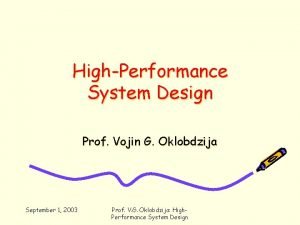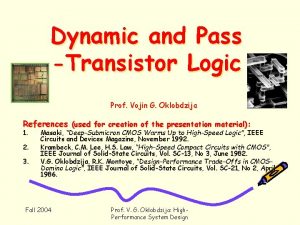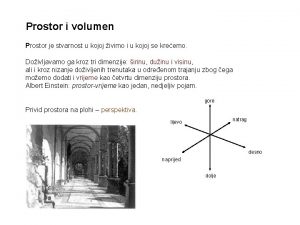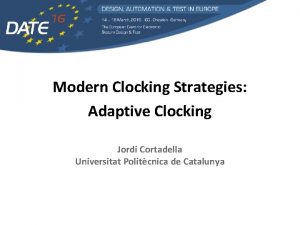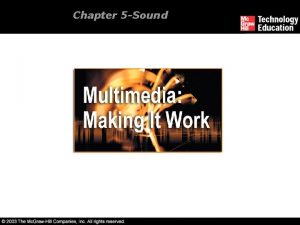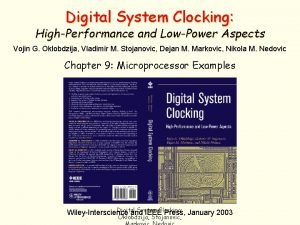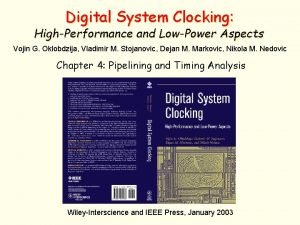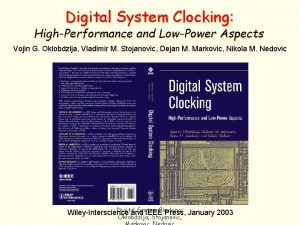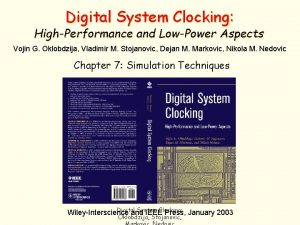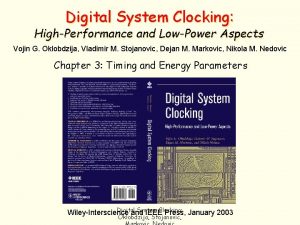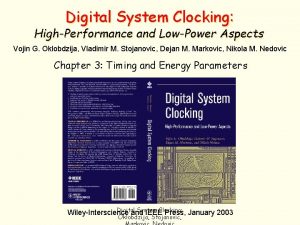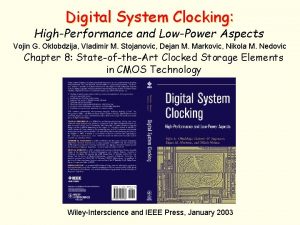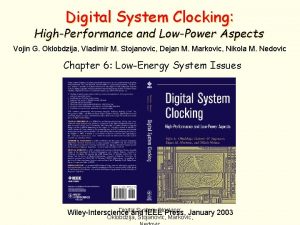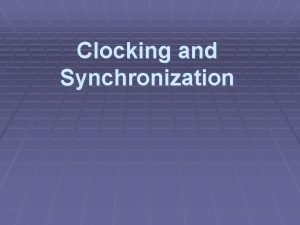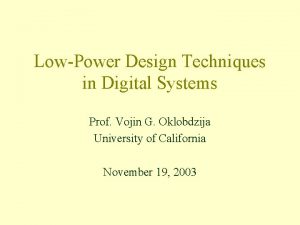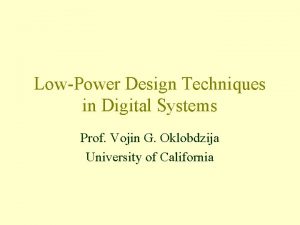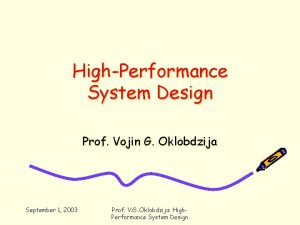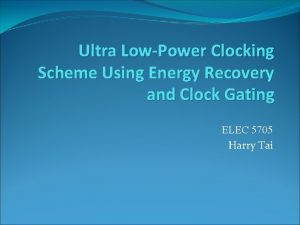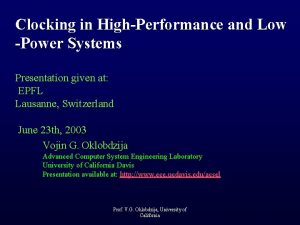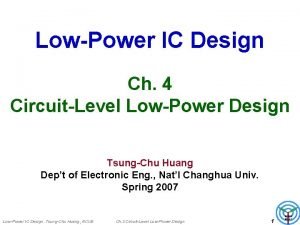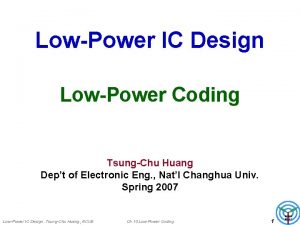Digital System Clocking HighPerformance and LowPower Aspects Vojin

























- Slides: 25

Digital System Clocking: High-Performance and Low-Power Aspects Vojin G. Oklobdzija, Vladimir M. Stojanovic, Dejan M. Markovic, Nikola M. Nedovic Chapter 6: Low-Energy System Issues Digital System Clocking: Wiley-Interscience and IEEE Press, January 2003 Oklobdzija, Stojanovic,

Switching Energy Clock is the highest activity signal Switching energy is dominant a- probability of a 0 -1 transition Ci – total switched capacitance at node i Vswing(i) – voltage swing at node i VDD – supply voltage N – number of nodes Energy is best reduced by scaling down VDD, but this also means performance degradation Nov. 14, 2003 Digital System Clocking: Oklobdzija, Stojanovic, Markovic, Nedovic 2

Pulsed Designs Scale the Best with VDD (a) (b) (Delay is normalized to FO 4 at its respective VDD. FO 4 as defined in this example increases with VDD performance degradation) Impact of Vdd on (a) delay, and (b) internal race immunity (0. 25 mm, light load). (Markovic et al. 2001), Copyright © 2001 IEEE Nov. 14, 2003 Digital System Clocking: Oklobdzija, Stojanovic, Markovic, Nedovic 3

Other Energy Reduction Techniques • Low-Swing Circuit Techniques • Reduced-swing Clk drivers • CSE redesign • N-only CSEs with Low-Vcc Clk • Clock Gating • Global • Local • Dual-Edge Triggering • Latch-mux • Pulsed-latch • Flip-flop Nov. 14, 2003 Digital System Clocking: Oklobdzija, Stojanovic, Markovic, Nedovic 4

Other Energy Reduction Techniques • Low-Swing Circuit Techniques • Reduced-swing Clk drivers • CSE redesign • N-only CSEs with Low-Vcc Clk • Clock Gating • Global • Local • Dual-Edge Triggering • Latch-mux • Pulsed-latch • Flip-flop Nov. 14, 2003 Digital System Clocking: Oklobdzija, Stojanovic, Markovic, Nedovic 5

Low-Swing Clocking, Option #1: Clock Driver Re-design 50% power reduction with half-swing clock (minus some penalty in clock drivers) Clock driver for half-swing clocking (Kojima at al. 1995), Copyright © 1995 IEEE Nov. 14, 2003 Digital System Clocking: Oklobdzija, Stojanovic, Markovic, Nedovic 6

Low-Swing Clocking, Option #2: CSE Re-design PMOS does not fully turn-off Reduced clock-swing flip-flop (Kawaguchi and Sakurai, 1998), Copyright © 1998 IEEE Nov. 14, 2003 Digital System Clocking: Oklobdzija, Stojanovic, Markovic, Nedovic 7

Low-Swing Clocking, Option #3: N-only CSEs N-only clocked transistors, M-S Latch Example (N 1 and N 2 improve pull-up on SM) N-Only clocked M-S latch Nov. 14, 2003 Digital System Clocking: Oklobdzija, Stojanovic, Markovic, Nedovic 8

Other Energy Reduction Techniques • Low-Swing Circuit Techniques • Reduced-swing Clk drivers • CSE redesign • N-only CSEs with Low-Vcc Clk • Clock Gating • Global • Local • Dual-Edge Triggering • Latch-mux • Pulsed-latch • Flip-flop Nov. 14, 2003 Digital System Clocking: Oklobdzija, Stojanovic, Markovic, Nedovic 9

Clock Gating, Option #1: Global Clock Gating Time-mux (no gating!) Global Clk Gating Used to save clocking energy when data activity is low (a) Nongated clock circuit, (b) gated clock circuit. (Kitahara et al. 1998), Copyright © 1998 IEEE Nov. 14, 2003 Digital System Clocking: Oklobdzija, Stojanovic, Markovic, Nedovic 10

Clock Gating, Option #2: Local Clock Gating Data-transition look-ahead latch (Nogawa and Ohtomo, 1998), Copyright © 1998 IEEE Nov. 14, 2003 Digital System Clocking: Oklobdzija, Stojanovic, Markovic, Nedovic 11

Local Clock Gating, Another Example Conditional capture flip-flop (Kong et al. 2000), Copyright © 2000 IEEE Nov. 14, 2003 Digital System Clocking: Oklobdzija, Stojanovic, Markovic, Nedovic 12

Other Energy Reduction Techniques • Low-Swing Circuit Techniques • Reduced-swing Clk drivers • CSE redesign • N-only CSEs with Low-Vcc Clk • Clock Gating • Global • Local • Dual-Edge Triggering • Latch-mux • Pulsed-latch • Flip-flop Nov. 14, 2003 Digital System Clocking: Oklobdzija, Stojanovic, Markovic, Nedovic 13

Dual-Edge Triggering, Option #1: Latch-Mux Used to save clocking energy regardless of data activity! Dual-edge-triggered latch-mux design Nov. 14, 2003 Digital System Clocking: Oklobdzija, Stojanovic, Markovic, Nedovic 14

DET Latch-Mux: Circuit Example Dual-edge-triggered latch-mux circuit (Llopis and Sachdev, 1996), Copyright © 1996 IEEE Nov. 14, 2003 Digital System Clocking: Oklobdzija, Stojanovic, Markovic, Nedovic 15

Dual-Edge Triggering, Option #2: Pulsed-Latch Dual-edge-triggered pulsed-latch design Nov. 14, 2003 Digital System Clocking: Oklobdzija, Stojanovic, Markovic, Nedovic 16

DET Pulsed-Latch: Circuit Examples Pulsed-latch: (a) single-edge-triggered; (b) dual-edge-triggered Nov. 14, 2003 Digital System Clocking: Oklobdzija, Stojanovic, Markovic, Nedovic 17

Dual-Edge Triggered Flip-Flop Dual-edge-triggered flip-flop design Nov. 14, 2003 Digital System Clocking: Oklobdzija, Stojanovic, Markovic, Nedovic 18

DET Flip-Flop: Circuit Example DET symmetric pulse-generator flip-flop Nov. 14, 2003 Digital System Clocking: Oklobdzija, Stojanovic, Markovic, Nedovic 19

Clock Distribution H-tree clock distribution network Nov. 14, 2003 Digital System Clocking: Oklobdzija, Stojanovic, Markovic, Nedovic 20

Clocking Power: SET vs. DET Clocking power in single- and dual-edge-triggered systems Nov. 14, 2003 Digital System Clocking: Oklobdzija, Stojanovic, Markovic, Nedovic 21

Glitch Robust Design Nov. 14, 2003 Digital System Clocking: Oklobdzija, Stojanovic, Markovic, Nedovic 22

Average Glitching Energy in CSEs Comparison of average glitching energy in CSEs (Markovic at al. 2001), Copyright © 2001 IEEE Nov. 14, 2003 Digital System Clocking: Oklobdzija, Stojanovic, Markovic, Nedovic 23

Comparison of Eglitching and Eswitching Glitching energy as a percentage of switching energy in representative CSEs showing the greatest glitch sensitivity of the gated designs Nov. 14, 2003 Digital System Clocking: Oklobdzija, Stojanovic, Markovic, Nedovic 24

Summary • Energy best reduced by VDD scaling • Penalty in performance • Reducing Clk swing only reduces EClk • Still penalty in performance • Clock gating • Reduces EClk at low-activity • No penalty in perf. if gating is outside crit-path • Dual-Edge Triggering • Reduces EClk ideally by 2 x • Small or no performance degradation Nov. 14, 2003 Digital System Clocking: Oklobdzija, Stojanovic, Markovic, Nedovic 25
 Workshop clocking system
Workshop clocking system Vojin oklobdzija
Vojin oklobdzija Vojin oklobdzija
Vojin oklobdzija 2 input nand gate using pass transistor logic
2 input nand gate using pass transistor logic Vojin bakić
Vojin bakić Prošupljena masa
Prošupljena masa 7 series fpgas clocking resources user guide
7 series fpgas clocking resources user guide Adaptive clocking
Adaptive clocking Crucial aspects of preparing digital audio files
Crucial aspects of preparing digital audio files Unique features of digital markets
Unique features of digital markets The visual and artistic aspects of presenting a product
The visual and artistic aspects of presenting a product Have a look at these pictures
Have a look at these pictures Chapter 2 legal and ethical aspects of nursing
Chapter 2 legal and ethical aspects of nursing Preventive promotive and curative aspects of health
Preventive promotive and curative aspects of health Ellis 2003
Ellis 2003 Professional issues ethics and computer law
Professional issues ethics and computer law Line and staff aspects of hrm
Line and staff aspects of hrm Marketing and financial aspects
Marketing and financial aspects Which intellectual trait includes conscious understanding
Which intellectual trait includes conscious understanding Neo analytic
Neo analytic Perbedaan warga digital dan kewargaan digital
Perbedaan warga digital dan kewargaan digital Digital data digital signals
Digital data digital signals Data encoding and transmission
Data encoding and transmission E-commerce: digital markets, digital goods
E-commerce: digital markets, digital goods Data encoding techniques
Data encoding techniques Luxinnovation logo
Luxinnovation logo


